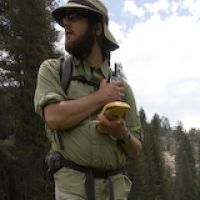Lucas et al., 2014
Determination of specific yield of montane meadow soils, Sierra Nevada, CA
R. Lucas; M. Conklin; R. Rice; T. Ghezzehei (2014)
American Geophysical Union, Fall Meeting 2014, abstract #H53B-0852
-
Sierra, GRAD STUDENT
-
Sierra, INVESTIGATOR
Abstract
Utilizing diurnal fluctuations of shallow groundwater tables to estimate evapotranspiration (ET) is a well established approach. This approach is advantageous in that ET can be estimated with little infrastructure and at relatively low cost. Most studies that use this method rely on some estimation of the specific yield, Sy, of the soil. Specific yield is the volume of water drained form a soil or rock divided by the volume of soil from which it drained. Established methods for determining Sy include field and laboratory approaches that either measure the volume of water drained from a known volume of soil or measuring the change in groundwater elevation after some perturbation, such as a precipitation or pumping event, of known water volume. Most methods for determining Sy result in a single value for a given soil volume. In shallow water table environments, soil specific yield is transient by nature, varying with depth to groundwater, time allowed for drainage, and whether the soil is experiencing wetting or drying conditions. When applied in ET calculations, inadequate estimates of Sy can result in large errors in calculated ET. We utilize eddy covariance techniques, in situ soil moisture sensors, and meteorological data to constrain specific yield values for soils in ten montane meadows in the Sierra Nevada Mountains, CA. Meadows conditions range from relatively pristine meadows to degraded and restored meadow systems. Quantifying ET in these meadows is important for understanding the meadow hydrology and connection to the greater catchments. Results from our approaches highlight the transient nature of soil specific yield. Calculated values of specific yield ranged from 0.03-0.16; higher values were obtained when using meteorological data to calculate Potential ET and lower values were obtained with eddy covariance techniques. Specific yield values determined from this study were subsequently used to train neural network models for estimating soil specific yield and meadow ET. Meteorological parameters, day of year, time of day, and depth to water are among the input values used in the neural network models. These models allow us to better calculate ET in the meadows for the duration of the input parameter time series; ET was calculated as far back as 2008.
Citation
R. Lucas; M. Conklin; R. Rice; T. Ghezzehei (2014): Determination of specific yield of montane meadow soils, Sierra Nevada, CA. American Geophysical Union, Fall Meeting 2014, abstract #H53B-0852.
 This Paper/Book acknowledges NSF CZO grant support.
This Paper/Book acknowledges NSF CZO grant support.
Explore Further


